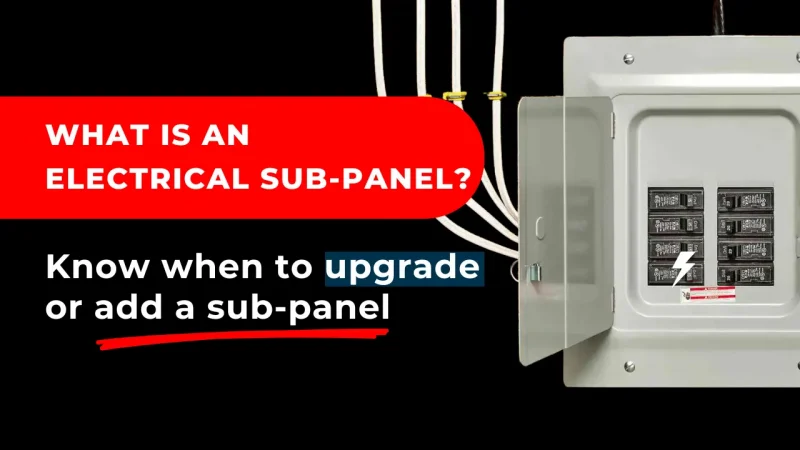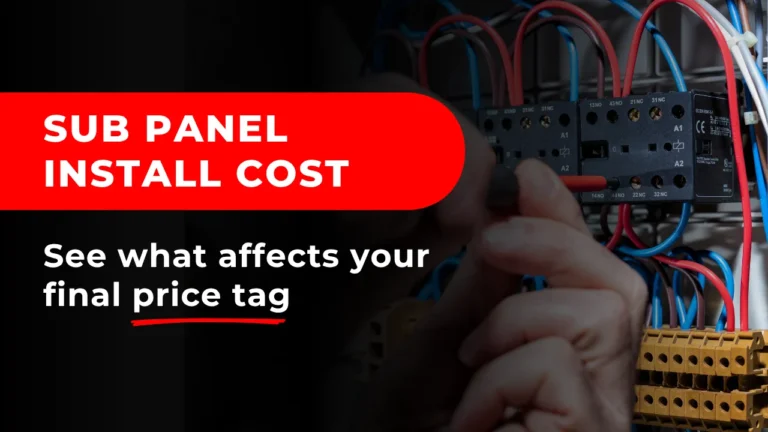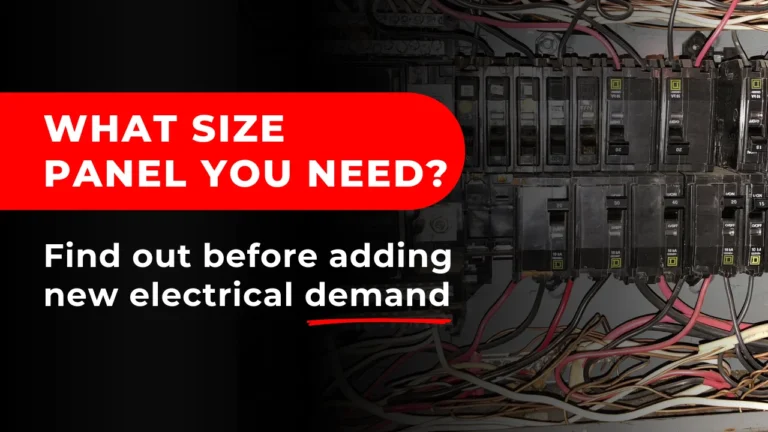An electrical sub-panel, also known as a secondary panel or breaker box, is a smaller service panel installed downstream from your main electrical panel. While the main one is the primary distribution point for electrical circuits in your home, the sub-panel is a secondary distribution center. It gets power from the main panel and distributes it to specific areas or circuits within your home. If you’ve ever wondered what an electrical sub-panel is and why you might need one, this guide is for you.
Common Uses of Electrical Sub-Panels
Sub-panels are commonly used in a variety of situations. One of the most frequent uses is to expand the electrical capacity of a home or business. As your electrical needs grow, you might find that your main panel doesn’t have enough space for additional circuit breakers. Installing a sub-panel allows you to add more circuits without overloading the main panel.
Another common use is to provide dedicated circuits for specific areas or high-demand appliances. For example, if you have a workshop, garage, or a new addition to your home, a sub-panel can give you a centralized point to control the electrical distribution to that area. This not only makes it easier to manage the circuits but also improves safety by keeping high-demand circuits separate from the main living areas.
Finally, sub-panels can help enhance the overall safety and organization of your electrical system. By having a sub-panel, you can reduce the risk of overloading circuits, which can lead to electrical fires. It also makes it easier to troubleshoot electrical issues since the circuits are organized more logically.
What’s in a Sub-Panel?
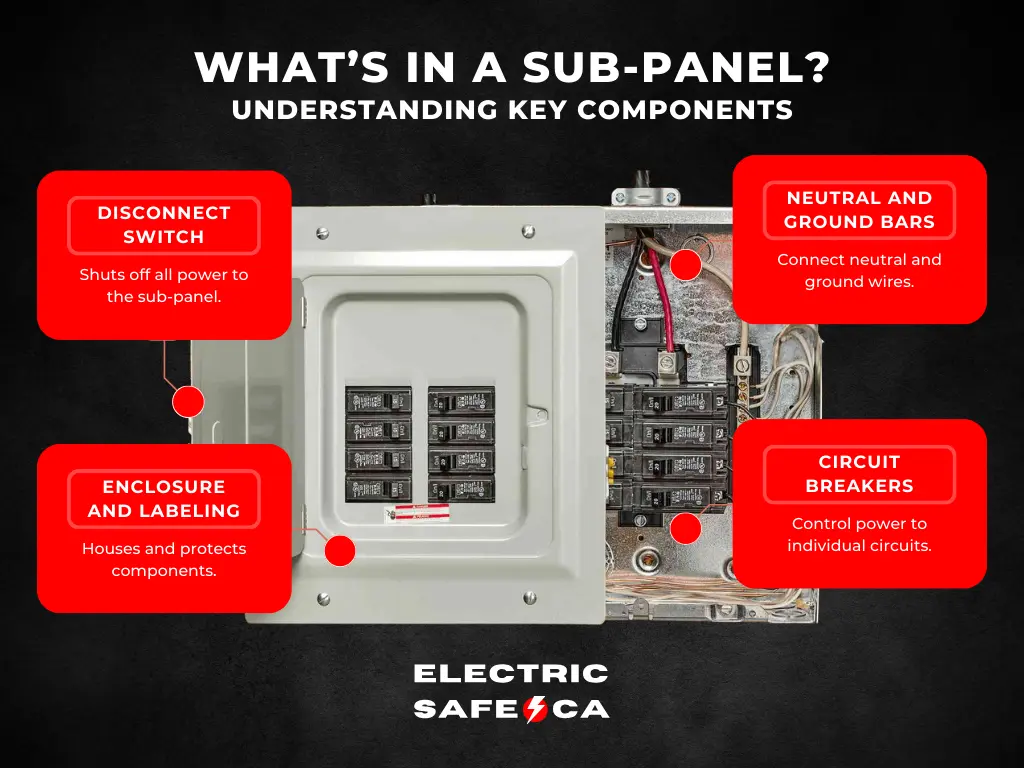
An electrical sub-panel consists of several components that work together to safely distribute electricity safely. These include:
- Main Breaker or Disconnect Switch: This is the switch that allows you to turn off all the power coming into the sub-panel. It’s a critical safety feature that lets you shut off power in an emergency or when performing maintenance.
- Circuit Breakers: These are the switches that control the power to individual circuits. They come in various ratings depending on the electrical load of each circuit. Circuit breakers protect your home by tripping and cutting off power if there’s an overload or short circuit.
- Neutral and Ground Bus Bars: These bars are used to connect the neutral and ground wires from the circuits. Proper grounding is essential for electrical safety, helping to prevent electrical shocks and fires.
- Enclosure and Labeling: The sub-panel enclosure houses all the components and protects them from damage. Proper labeling is also important to identify which circuit breakers control which areas or appliances in your home.
How Sub-Panels Improve Electrical Systems
Adding a sub-panel to your electrical system can bring several benefits. First, it helps improve circuit distribution and load management. By spreading out the electrical load, you can prevent overloading the main panel and individual circuits, which reduces the risk of electrical fires. Other benefits include:
- Sub-panels increase safety by providing dedicated circuits for high-demand areas or appliances. This ensures that each circuit has enough capacity to handle the load, reducing the risk of tripping breakers and potential hazards.
- With a sub-panel, circuits are more logically organized, making it simpler to identify and address issues. If a circuit trips, you can quickly locate the sub-panel and reset the breaker without having to search through a crowded main panel.
Overall, sub-panels offer a practical solution for managing your electrical system more efficiently. They not only improve the safety and functionality of your home’s electrical setup but also make future expansions and modifications easier. By investing in a sub-panel, you’re taking a proactive step towards a safer and more organized electrical system.
When to Upgrade or Add a Sub-Panel
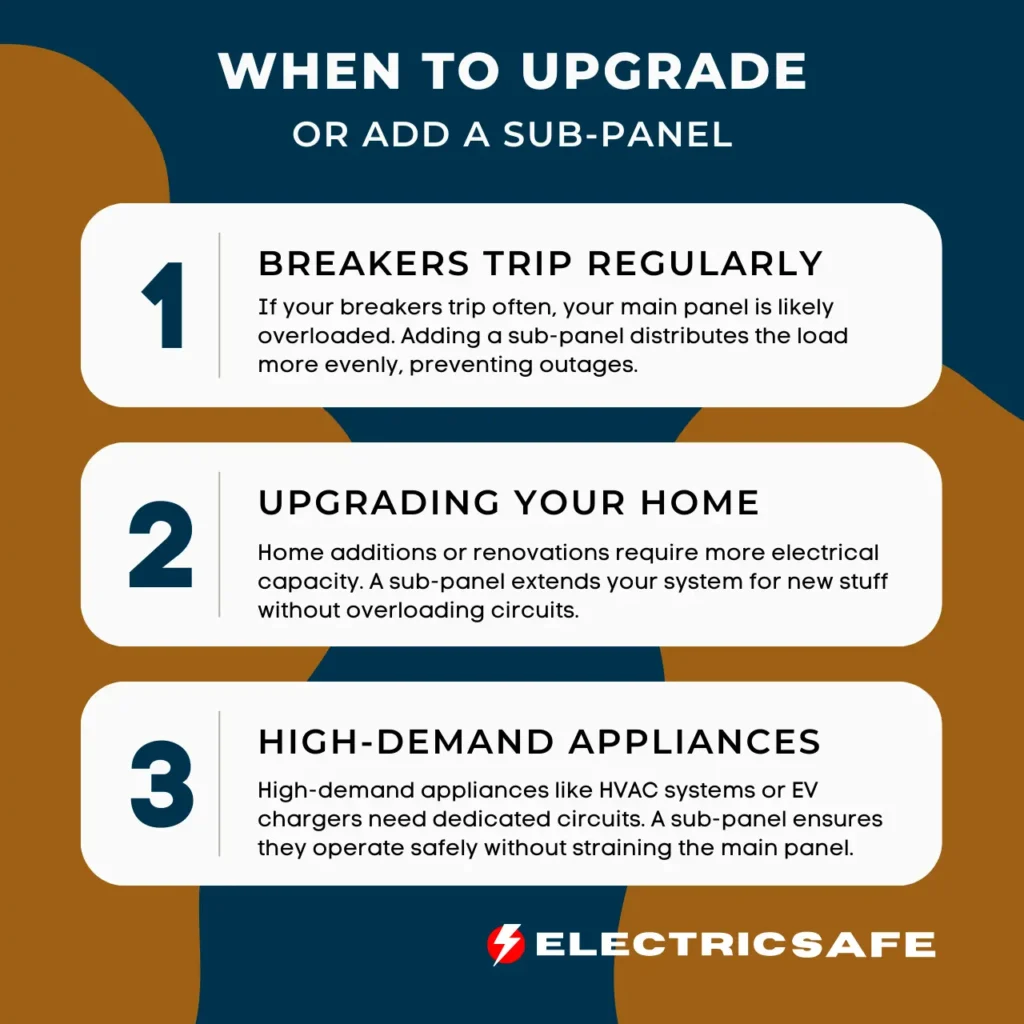
There are several signs that indicate it might be time to upgrade your electrical system with a sub-panel.
Breakers Trip Regularly
If you frequently trip breakers or experience power outages, your main panel is likely overloaded. Adding a sub-panel can help distribute the load more evenly across multiple circuits, reducing the strain on your main panel and preventing these issues.
You’re Upgrading Your Home
You might need a sub-panel if you’re planning a home addition or renovation. These projects often require additional electrical capacity to accommodate new rooms, appliances, or systems. For instance, if you’re adding a new kitchen, bathroom, or even a garage, the electrical demand can significantly increase. A sub-panel allows you to extend your electrical system to new areas without overloading the existing circuits.
You Use High-Demand Appliances
High-demand appliances also require the use of a sub-panel. Items such as HVAC systems, hot tubs, or electric vehicle chargers consume a large amount of electricity and need dedicated circuits to operate safely. Installing a sub-panel ensures that these high-demand appliances have the necessary capacity to function without compromising the rest of your electrical system.
When deciding to upgrade or add a sub-panel, consider factors like the following:
- Assess the age and condition of your existing electrical system. Older systems might not be equipped to handle modern electrical loads, making an upgrade necessary.
- Evaluate the capacity of your main panel. If it’s already full or nearing its limit, a sub-panel can provide the extra space needed for additional circuits.
- Think about any planned expansions, new appliances, or lifestyle changes that could increase your electrical consumption. Preparing for future demands now can save you time and money down the line.
A qualified electrician can inspect your current setup, provide recommendations, and handle the installation for you.
Looking to Add or Upgrade Your Sub-Panel?
If you’re considering adding or upgrading a sub-panel, it’s always best to consult with a professional electrician. At ElectricSafe, we’re here to help with all your electrical needs. Whether you need assistance with installation, upgrades, or maintenance, our team of experienced electricians is ready to ensure your system is safe and reliable.
For expert help with installing and maintaining your electrical sub-panel, contact ElectricSafe today. We’re dedicated to providing safe and efficient electrical solutions for your home or business. Call us to schedule a consultation and learn more about how we can help you with your electrical needs.

